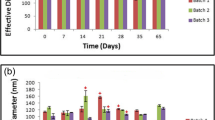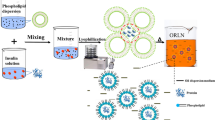Abstract
In the present study, we developed novel insulin-loaded hyaluronic acid (HA) nanoparticles for insulin delivery. The insulin-loaded HA nanoparticles were prepared by reverse-emulsion-freeze-drying method. This method led to a homogenous population of small HA nanoparticles with average size of 182.2 nm and achieved high insulin entrapment efficiencies (approximately 95%). The pH-sensitive HA nanoparticles as an oral delivery carrier showed advantages in protecting insulin against the strongly acidic environment of the stomach, and not destroying the junction integrity of epithelial cells which promise long-term safety for chronic insulin treatment. The results of transport experiments suggested that insulin-loaded HA nanoparticles were transported across Caco-2 cell monolayers mainly via transcellular pathway and their apparent permeability coefficient from apical to basolateral had more than twofold increase compared with insulin solution. The efflux ratio of P app (B to A) to P app (A to B) less than 1 demonstrated that HA nanoparticle-mediated transport of insulin across Caco-2 cell monolayers underwent active transport. The results of permeability through the rat small intestine confirmed that HA nanoparticles significantly enhanced insulin transport through the duodenum and ileum. Diabetic rats treated with oral insulin-loaded HA nanoparticles also showed stronger hypoglycemic effects than insulin solution. Therefore, these HA nanoparticles could be a promising candidate for oral insulin delivery.











Similar content being viewed by others
REFERENCES
Khafagy E, Morishita M, Onuki Y, Takayama K. Current challenges in non-invasive insulin delivery systems: a comparative review. Adv Drug Deliv Rev. 2007;59(15):1521–46.
Iyer H, Khedkar A, Verma M. Oral insulin—a review of current status. Diabetes Obes Metab. 2010;12(3):179–85.
Sarmento B, Ribeiro A, Veiga F, Sampaio P, Neufeld R, Ferreira D. Alginate/chitosan nanoparticles are effective for oral insulin delivery. Pharm Res. 2007;24(12):2198–206.
Santander-Ortega MJ, Bastos-Gonzalez D, Ortega-Vinuesa JL, Alonso MJ. Insulin-loaded PLGA nanoparticles for oral administration: an in vitro physico-chemical characterization. J Biomed Nanotechnol. 2009;5(1):45–53.
Almeida AJ, Souto E. Solid lipid nanoparticles as a drug delivery system for peptides and proteins. Adv Drug Deliv Rev. 2007;59(6):478–90.
Wang JJ, Zeng ZW, Xiao RZ, Xie T, Zhou GL, Zhan XR, et al. Recent advances of chitosan nanoparticles as drug carriers. Int J Nanomedicine. 2011;6:765–74.
Zhang N, Ping Q, Huang G, Xu W, Cheng Y, Han X. Lectin-modified solid lipid nanoparticles as carriers for oral administration of insulin. Int J Pharm. 2006;327(1–2):153–9.
Chalasani KB, Russell-Jones GJ, Yandrapu SK, Diwan PV, Jain SK. A novel vitamin B12-nanosphere conjugate carrier system for peroral delivery of insulin. J Control Release. 2007;117(3):421–9.
Zhang N, Li J, Jiang W, Ren C, Li J, Xin J, et al. Effective protection and controlled release of insulin by cationic beta-cyclodextrin polymers from alginate/chitosan nanoparticles. Int J Pharm. 2010;393(1–2):212–8.
Woitiski CB, Carvalho RA, Ribeiro AJ, Neufeld RJ, Veiga F. Strategies toward the improved oral delivery of insulin nanoparticles via gastrointestinal uptake and translocation. BioDrugs. 2008;22(4):223–7.
Chen MC, Sonaje K, Chen KJ, Sung HW. A review of the prospects for polymeric nanoparticle platforms in oral insulin delivery. Biomaterials. 2011;32(36):9826–38.
Li SD, Huang L. Pharmacokinetics and biodistribution of nanoparticles. Mol Pharm. 2008;5(4):496–504.
Bodnár M, Daróczi L, Batta G, Bakó J, Hartmann JF, Borbély J. Preparation and characterization of cross-linked hyaluronan nanoparticles. Colloid Polym Sci. 2009;287:991–1000.
Necas J, Bartosikova L, Brauner P, Kolar J. Hyaluronic acid (hyaluronan): a review. Vet Med. 2008;53(8):397–411.
Kogan G, Soltes L, Stern R, Gemeiner P. Hyaluronic acid: a natural biopolymer with a broad range of biomedical and industrial applications. Biotechnol Lett. 2007;29(1):17–25.
Holmes K, Lantz LM, Fowlkes BJ, Schmid I, Giorgi JV. Preparation of cells and reagents for flow cytometry. In: Coligan JE, Kruisbeek AM, Margulles DH, Shevac EM, Strober W, editors. Current protocols in immunology. New York: Wiley; 2000.
Huang L, Berry L, Ganga S, Janosky B, Chen A, Roberts J, et al. Relationship between passive permeability, efflux, and predictability of clearance from in vitro metabolic intrinsic clearance. Drug Metab Dispos. 2010;38(2):223–31.
Luo Y, Kirker KR, Prestwich GD. Cross-linked hyaluronic acid hydrogel films: new biomaterials for drug delivery. J Control Release. 2000;69(1):169–84.
Xie SY, Wang SL, Zhao BK, Han C, Wang M, Zhou WZ. Effect of PLGA as a polymeric emulsifier on preparation of hydrophilic protein-loaded solid lipid nanoparticles. Coll Surf B: Biointer. 2008;67(2):199–204.
Cui FD, Tao AJ, Cun DM, Zhang LQ, Shi K. Preparation of insulin loaded PLGA-Hp55 nanoparticles for oral delivery. J Pharm Sci. 2007;96(2):421–7.
Zhang Y, Wei W, Lv P, Wang L, Ma G. Preparation and evaluation of alginate-chitosan microspheres for oral delivery of insulin. Eur J Pharm Biopharm. 2011;77(1):11–9.
Liebert MA. Final report on the safety assessment of adipic acid dihydrazide. J Am Coll Toxico. 1994;13(3):154–6.
Kimura ET, Ebert DM, Dodge PW. Acute toxicity and limits of solvent residue for sixteen organic solvents. Toxicol Appl Pharmacol. 1971;19(4):699–704.
Damgé C, Maincent P, Ubrich N. Oral delivery of insulin associated to polymeric nanoparticles in diabetic rats. J Control Release. 2007;117(2):163–70.
Brown MB, Jones SA. Hyaluronic acid: a unique topical vehicle for the localized delivery of drugs to the skin. J Eur Acad Dermatol Venereol. 2005;19(3):308–18.
Ramesan RM, Sharma CP. Challenges and advances in nanoparticle-based oral insulin delivery. Expert Rev Med Devices. 2009;6(6):665–76.
Walgren RA, Walle UK, Walle T. Transport of quercetin and its glucosides across human intestinal epithelial Caco-2 cells. Biochem Pharmacol. 1998;55(10):1721–7.
Lai Y, Chiang PC, Blom JD, Li N. Comparison of in vitro nanoparticles uptake in various cell lines and in vivo pulmonary cellular transport in intratracheally dosed rat model. Nanoscale Res Lett. 2008;3(9):321–9.
MacCallum A, Hardy SP, Everest PH. Campylobacter jejuni inhibits the absorptive transport functions of Caco-2 cells and disrupts cellular tight junctions. Microbiology. 2005;151(Pt 7):2451–8.
Nagpal K, Singh SK, Mishra DN. Chitosan nanoparticles: a promising system in novel drug delivery. Chem Pharm Bull(Tokyo). 2010;58(11):1423–30.
ACKNOWLEDGMENT
The authors gratefully acknowledge the Fundamental Research Funds for the Central Universities (project no. 09ykpy67) for their financial support of this research.
Author information
Authors and Affiliations
Corresponding author
Rights and permissions
About this article
Cite this article
Han, L., Zhao, Y., Yin, L. et al. Insulin-Loaded pH-Sensitive Hyaluronic Acid Nanoparticles Enhance Transcellular Delivery. AAPS PharmSciTech 13, 836–845 (2012). https://doi.org/10.1208/s12249-012-9807-2
Received:
Accepted:
Published:
Issue Date:
DOI: https://doi.org/10.1208/s12249-012-9807-2




